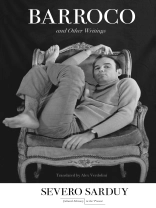Severo Sarduy was among the most important figures in twentieth-century Latin American fiction and a major representative of the literary tendency to which he gave the name Neobaroque. While most of Sarduy’s literary work is available in English, his theoretical writings have largely remained untranslated. This volume—presenting Sarduy’s central theoretical contribution, Barroco (1974), alongside other related works—remedies that oversight.
Barroco marks a watershed in postwar thought on the Baroque, both in French post-structuralism and in the Latin American context. Sarduy traces a double history, reading events in the history of science alongside developments in the history of art, architecture, and literature. What emerges is a theory of the Baroque as decentering and displacement, as supplement and excess, a theory capacious enough to account for the old European Baroque as well as its queer, Latin American and global futures.
In addition to Barroco, this volume includes texts spanning Sarduy’s career, from 1960s essays published originally in Tel Quel to late works from the 1980s and ’90s. It thus offers a complete picture of Sarduy’s thinking on the Baroque.
Inhoudsopgave
Note on Texts and Translation
Introduction
ONE
0. Echo Chamber I. The Word ‘Barroco
I. The Word ‘Barroco
II. Cosmology before the Baroque
III. Baroque Cosmology: Kepler
IV. Cosmology after the Baroque
V. Supplement
TWO
I. Zero
II. Circle
III. Cycle
Other Writings
Metaphor Squared: On Góngora
Cubes
The Fury of the Paintbrush
Furious Baroque
The Heir
Fractal Baroque
Notes
Over de auteur
Severo Sarduy (1937-1993) was a Cuban novelist, poet, playwright, painter, critic, and winner of the Prix Médicis Étranger.
Alex Verdolini is a Ph D candidate in Comparative Literature at Yale University and teaches at the Cooper Union.
Iván Hofman is a Ph D candidate in Comparative Literature at New York University.












